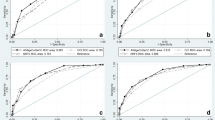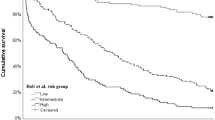Abstract
Summary
This study developed an easy-to-use mortality prediction tool, which showed an acceptable discrimination and no significant lack of fit. The GeRi-Score was able to predict mortality and could distinguish between mild, moderate and high risk groups. Therefore, the GeRi-Score might have the potential to distribute the intensity of medical care.
Purpose
Several mortality-predicting tools for hip fracture patients are available, but all consist of a high number of variables, require a time-consuming evaluation and/or are difficult to calculate. The aim of this study was to develop and validate an easy-to-use score, which depends mostly on routine data.
Methods
Patients from the Registry for Geriatric Trauma were divided into a development and a validation group. Logistic regression models were used to build a model for in-house mortality and to obtain a score. Candidate models were compared using Akaike information criteria (AIC) and likelihood ratio tests. The quality of the model was tested using the area under the curve (AUC) and the Hosmer–Lemeshow test.
Results
38,570 patients were included, almost equal distributed to the development and to the validation dataset. The AUC was 0.727 (95% CI 0.711 – 0.742) for the final model, AIC resulted in a significant reduction in deviance compared to the basic model, and the Hosmer–Lemeshow test showed no significant lack of fit (p = 0.07). The GeRi-Score predicted an in-house mortality of 5.3% vs. 5.3% observed mortality in the development dataset and 5.4% vs. 5.7% in the validation dataset. The GeRi-Score was able to distinguish between mild, moderate and high risk groups.
Conclusions
The GeRi-Score is an easy-to-use mortality-predicting tool with an acceptable discrimination and no significant lack of fit. The GeRi-Score might have the potential to distribute the intensity of perioperative medical care in hip fracture surgery and can be used in quality management programs as benchmark tool.


Similar content being viewed by others
Data availability
Not applicable
Code availability
Not applicable
References
Veronese N, Maggi S (2018) Epidemiology and social costs of hip fracture. Injury 49:1458–1460. https://doi.org/10.1016/j.injury.2018.04.015
Carow J, Carow JB, Coburn M et al (2017) Mortality and cardiorespiratory complications in trochanteric femoral fractures: a ten year retrospective analysis. Int Orthop 41:2371–2380. https://doi.org/10.1007/s00264-017-3639-3
Abrahamsen B, van Staa T, Ariely R et al (2009) Excess mortality following hip fracture: a systematic epidemiological review. Osteoporos Int 20:1633–1650. https://doi.org/10.1007/s00198-009-0920-3
Lefaivre KA, Macadam SA, Davidson DJ et al (2009) Length of stay, mortality, morbidity and delay to surgery in hip fractures. J Bone Joint Surg Br 91:922–927. https://doi.org/10.1302/0301-620X.91B7.22446
Narula S, Lawless A, D’Alessandro P et al (2020) Clinical Frailty Scale is a good predictor of mortality after proximal femur fracture: A cohort study of 30-day and one-year mortality. Bone Jt Open 1:443–449. https://doi.org/10.1302/2633-1462.18.BJO-2020-0089.R1
Schoeneberg C, Aigner R, Pass B et al (2021) Effect of time-to-surgery on in-house mortality during orthogeriatric treatment following hip fracture: a retrospective analysis of prospectively collected data from 16,236 patients of the AltersTraumaRegister DGU®. Injury 52. https://doi.org/10.1016/j.injury.2020.09.007
Middleton M, Wan B, da Assunçao R (2017) Improving hip fracture outcomes with integrated orthogeriatric care: a comparison between two accepted orthogeriatric models. Age Ageing 46:465–470. https://doi.org/10.1093/ageing/afw232
Folbert EC, Hegeman JH, Vermeer M et al (2017) Improved 1-year mortality in elderly patients with a hip fracture following integrated orthogeriatric treatment. Osteoporos Int 28:269–277. https://doi.org/10.1007/s00198-016-3711-7
Prestmo A, Hagen G, Sletvold O et al (2015) Comprehensive geriatric care for patients with hip fractures: a prospective, randomised, controlled trial. Lancet 385:1623–1633. https://doi.org/10.1016/S0140-6736(14)62409-0
Rapp K, Becker C, Todd C et al (2020) The association between orthogeriatric co-management and mortality following hip fracture. Dtsch Arztebl Int 117:53–59. https://doi.org/10.3238/arztebl.2020.0053
Knobe M, Böttcher B, Coburn M et al (2019) Geriatric Trauma Center DGU®: evaluation of clinical and economic parameters: a pilot study in a german university hospital. Unfallchirurg 122:134–146. https://doi.org/10.1007/s00113-018-0502-y
Schoeneberg C, Pass B, Volland R et al (2021) Four-month outcome after proximal femur fractures and influence of early geriatric rehabilitation: data from the German Centres of Geriatric Trauma DGU. Arch Osteoporos 16:68. https://doi.org/10.1007/s11657-021-00930-9
Friess T, Hartwig E, Liener U et al (2016) Geriatric trauma centers from the idea to implementation. What has been achieved? Unfallchirurg 119:7–11. https://doi.org/10.1007/s00113-015-0114-8
Krause U, Jung K (2016) Geriatric Fracture Centre (German Trauma Society): guidelines and certification to improve geriatric trauma care. Innov Surg Sci 1. https://doi.org/10.1515/iss-2016-0026
Karres J, Heesakkers NA, Ultee JM et al (2015) Predicting 30-day mortality following hip fracture surgery: evaluation of six risk prediction models. Injury 46:371–377. https://doi.org/10.1016/j.injury.2014.11.004
Maxwell MJ, Moran CG, Moppett IK (2008) Development and validation of a preoperative scoring system to predict 30 day mortality in patients undergoing hip fracture surgery. Br J Anaesth 101:511–517. https://doi.org/10.1093/bja/aen236
Copeland GP, Jones D, Walters M (1991) POSSUM: a scoring system for surgical audit. Br J Surg 78:355–360. https://doi.org/10.1002/bjs.1800780327
Karres J, Kieviet N, Eerenberg J-P et al (2018) Predicting early mortality after hip fracture surgery: the hip fracture estimator of mortality Amsterdam. J Orthop Trauma 32:27–33. https://doi.org/10.1097/BOT.0000000000001025
Hirose J, Mizuta H, Ide J et al (2008) E-PASS for predicting postoperative risk with hip fracture: a multicenter study. Clin Orthop Relat Res 466:2833–2841. https://doi.org/10.1007/s11999-008-0377-2
Hodkinson HM (2012) Evaluation of a mental test score for assessment of mental impairment in the elderly. 1972. Age Ageing 41 Suppl 3:iii35-40. https://doi.org/10.1093/ageing/afs148
Hu F, Jiang C, Shen J et al (2012) Preoperative predictors for mortality following hip fracture surgery: a systematic review and meta-analysis. Injury 43:676–685. https://doi.org/10.1016/j.injury.2011.05.017
Smith T, Pelpola K, Ball M et al (2014) Pre-operative indicators for mortality following hip fracture surgery: a systematic review and meta-analysis. Age Ageing 43:464–471. https://doi.org/10.1093/ageing/afu065
Endo A, Baer HJ, Nagao M et al (2018) Prediction model of in-hospital mortality after hip fracture surgery. J Orthop Trauma 32:34–38. https://doi.org/10.1097/BOT.0000000000001026
Schoeneberg C, Pass B, Oberkircher L et al (2021) Impact of concomitant injuries in geriatric patients with proximal femur fracture : an analysis of the Registry for Geriatric Trauma. Bone Joint J 103-B:1526–1533. https://doi.org/10.1302/0301-620X.103B9.BJJ-2021-0358.R1
AUC – Akademie der Unfallchirurgie, Arbeitskreis AltersTraumaRegister DGU® (2019) The geriatric trauma register of the DGU-current status, methods and publication guidelines. Unfallchirurg 122:820–822. https://doi.org/10.1007/s00113-019-0698-5
Lefering R, Huber-Wagner S, Nienaber U et al (2014) Update of the trauma risk adjustment model of the TraumaRegister DGU™: the Revised Injury Severity Classification, version II. Crit Care 18:476. https://doi.org/10.1186/s13054-014-0476-2
Champion HR, Copes WS, Sacco WJ et al (1990) The major trauma outcome study. J Trauma 30:1356–1365. https://doi.org/10.1097/00005373-199011000-00008
Baker SP, OʼNeill B, Haddon W et al (1974) The injury severity score. J Trauma 14:187–196. https://doi.org/10.1097/00005373-197403000-00001
Marufu TC, White SM, Griffiths R et al (2016) Prediction of 30-day mortality after hip fracture surgery by the Nottingham Hip Fracture Score and the Surgical Outcome Risk Tool. Anaesthesia 71:515–521. https://doi.org/10.1111/anae.13418
Nijmeijer WS, Folbert EC, Vermeer M et al (2016) Prediction of early mortality following hip fracture surgery in frail elderly: the Almelo Hip Fracture Score (AHFS). Injury 47:2138–2143. https://doi.org/10.1016/j.injury.2016.07.022
Wesdorp MA, Moerman S, Vochteloo AJH et al (2021) External validation of the Almelo Hip Fracture Score, a prediction model for early mortality following hip fracture surgery. Eur J Trauma Emerg Surg. https://doi.org/10.1007/s00068-021-01619-x
Holt G, Smith R, Duncan K et al (2008) Early mortality after surgical fixation of hip fractures in the elderly: an analysis of data from the scottish hip fracture audit. J Bone Joint Surg Br 90:1357–1363. https://doi.org/10.1302/0301-620X.90B10.21328
Mohamed K, Copeland GP, Boot DA et al (2002) An assessment of the POSSUM system in orthopaedic surgery. J Bone Joint Surg Br 84:735–739. https://doi.org/10.1302/0301-620x.84b5.12626
Hirose J, Mizuta H, Ide J et al (2008) Evaluation of estimation of physiologic ability and surgical stress (E-PASS) to predict the postoperative risk for hip fracture in elder patients. Arch Orthop Trauma Surg 128:1447–1452. https://doi.org/10.1007/s00402-007-0551-0
Hosmer DW Jr, Lemeshow S, Sturdivant RX (2013) Applied Logistic Regression. Wiley
Role of Registry for Geriatric Trauma (ATR-DGU)
Registry for Geriatric Trauma (ATR-DGU): The host of the Registry for Geriatric Trauma is the AUC—Academy for Trauma Surgery (AUC). According to the publication guideline, it is desirable to list the Registry for Geriatric Trauma (ATR-DGU) as a co-author. According to the guideline, it should read "… and the Registry for Geriatric Trauma" or "… on behalf of the Registry for Geriatric Trauma". Daniel Schmitz is the senior author of the manuscript.
Registry for Geriatric Trauma (ATR-DGU)10 support-atr@auc-online.de
10Working Committee on Geriatric Trauma Registry of the German Trauma Society (DGU), Berlin, Germany
Author information
Authors and Affiliations
Consortia
Corresponding author
Ethics declarations
Ethics approval
Ethical Vote was obtained from the ethics commission at the university of Marburg (AZ 46/16).
Consent to participate
A written consent of the patients to participate in the ATR-DGU is obtained from the participating clinics. Without this, an entry into the register is not possible.
Consent for publication
No personal data, which can be assigned to a person, will be published. For this type of study, formal consent is not required.
Conflicts of interest
None
Additional information
Publisher's note
Springer Nature remains neutral with regard to jurisdictional claims in published maps and institutional affiliations.
Rights and permissions
Springer Nature or its licensor (e.g. a society or other partner) holds exclusive rights to this article under a publishing agreement with the author(s) or other rightsholder(s); author self-archiving of the accepted manuscript version of this article is solely governed by the terms of such publishing agreement and applicable law.
About this article
Cite this article
Schoeneberg, C., Heuser, L., Rascher, K. et al. The Geriatrics at Risk Score (GeRi-Score) for mortality prediction in geriatric patients with proximal femur fracture – a development and validation study from the Registry for Geriatric Trauma (ATR-DGU). Osteoporos Int 34, 879–890 (2023). https://doi.org/10.1007/s00198-023-06719-5
Received:
Accepted:
Published:
Issue Date:
DOI: https://doi.org/10.1007/s00198-023-06719-5




